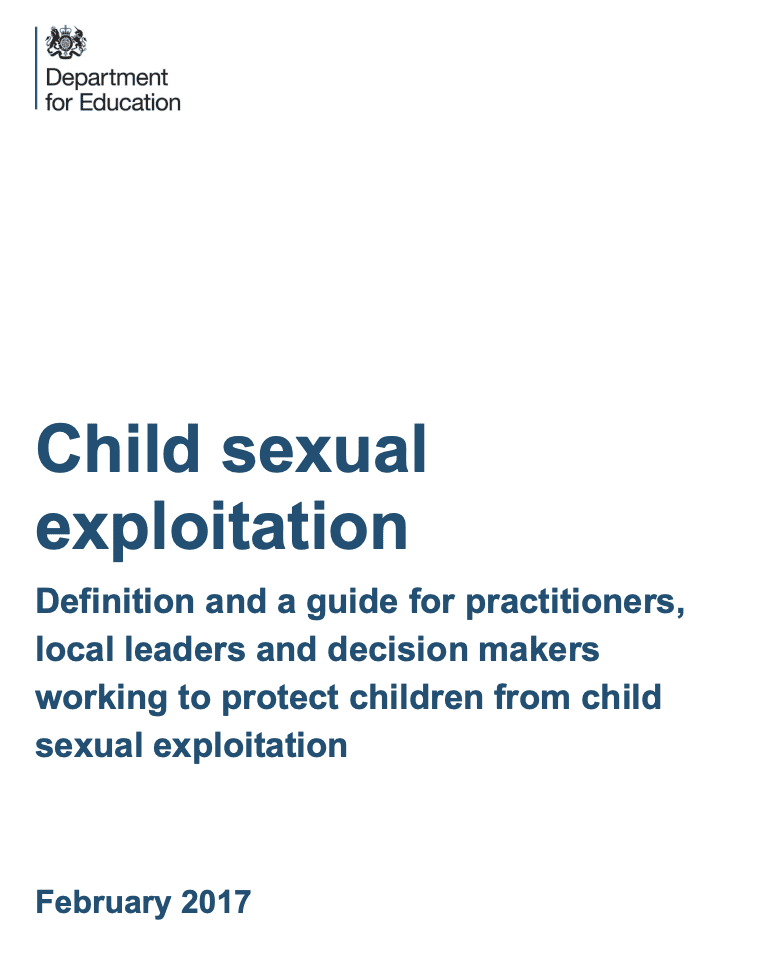
Child sexual exploitation: Definition and a guide for practitioners, local leaders and decision makers working to protect children from child sexual exploitation
Introduction
Child sexual exploitation is a crime with devastating and long lasting consequences for its victims and their families. Childhoods and family life can be ruined and this is compounded when victims, or those at risk of abuse, do not receive appropriate, immediate and on-going support. The first response to children, and support for them to access help, must be the best it can be from social workers, police, health practitioners and others who work with children and their families.
In Putting Children First (July 2016) the Government set out its ambitions to support vulnerable children to lead safe and positive lives, to become successful adults and to have the kind of happy childhood that we want for all our children. We want children and families to have confidence in turning to practitioners for help and protection from abuse, neglect and exploitation. This help and protection should be provided in a timely, enduring and flexible manner, and be the best it can possibly be. This requires children, parents and carers affected by child sexual exploitation to feel part of the solution and confident they will be believed. Practitioners should work together to reduce the immediate risk of harm to children and collaborate to develop long term strategies to improve children’s life chances.
This applies as much to child sexual exploitation as to other forms of abuse or neglect. The hidden nature of child sexual exploitation and the complexities involved means professional curiosity, and always being alert to the issue, is vital.
About this advice
This advice is non-statutory, and has been produced to help practitioners, local leaders and decision makers who work with children and families to identify child sexual exploitation and take appropriate action in response. This includes the management, disruption and prosecution of perpetrators.
This advice replaces the 2009 guidance Safeguarding children and young people from sexual exploitation. It should be read alongside Working Together to Safeguard Children (most recent updates available on gov.uk) which continues to provide statutory guidance covering the legislative requirements on services to safeguard and promote the welfare of children, including in relation to child sexual exploitation.
A child is anyone who has not yet reached their 18th birthday. Throughout this advice the terms ‘child’ and ‘children’ are used to refer to all those under the age of 18.
Who is this advice for?
This advice is intended to help all those working with children, and their parents and carers, to understand child sexual exploitation and what action should be taken to identify and support victims. The online annexes to this document set out work to tackle perpetrators, another critical element of an holistic response.
Section A is for everyone whose work brings them into contact with children and families, including those who work in early years, children’s social care, health, education (including schools), the police, adult services and youth offending teams. This section sets out first the background to the nature of child sexual exploitation, followed by a series of guiding principles. It is relevant to those working in the statutory, voluntary or the independent sectors, and applies in relation to all children and young people irrespective of whether they are living at home with their families and carers or away from home.
Section B is for those in strategic and management roles who are planning responses to child sexual exploitation within local authorities and other agencies working in partnership. It is relevant for Local Safeguarding Children Boards and any new arrangements required in legislation. However, all practitioners may find this information useful to support effective front-line practice on child sexual exploitation.
This advice is not intended to be a ‘step by step’ approach to addressing child sexual exploitation. It sets out the definition of child sexual exploitation; highlights potential vulnerabilities and indicators of abuse; and sets out appropriate action to take in response, using professional judgment and curiosity. Although it focuses on child sexual exploitation, the principles outlined here are those set out in Working Together covering all forms of exploitation, abuse and vulnerability in childhood and adolescence. The signs of abuse rarely present in clear, unequivocal ways (The Munro Review of Child Protection, 2011). What is important is that those working with children and families understand the totality of a child’s experience in order to assess the nature and level of risk faced by children and respond swiftly and proportionately.
Read more here.
